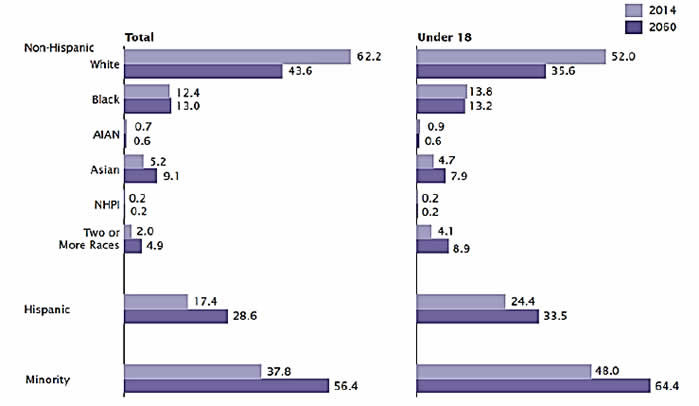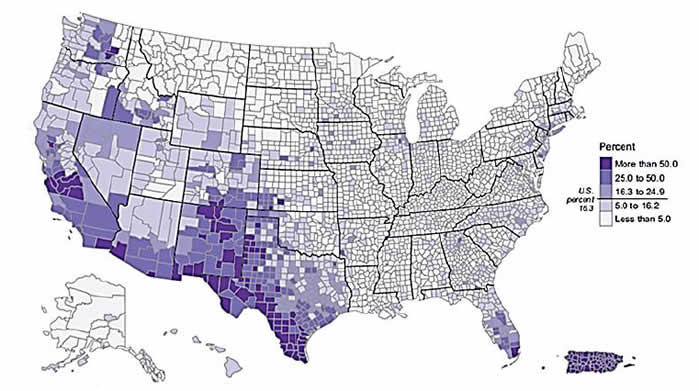National Healthcare Quality and Disparities Report
This chartbook is part of a family of documents and tools that support the National Healthcare Quality and Disparities Reports (QDR). The QDR includes annual reports to Congress mandated in the Healthcare Research and Quality Act of 1999 (P.L. 106-129). These reports provide a comprehensive overview of the quality of health care received by the general U.S. population and disparities in care experienced by different racial, ethnic, and socioeconomic groups. The purpose of the reports is to assess the performance of our health system and to identify areas of strengths and weaknesses in the health care system along three main axes: access to health care, quality of health care, and priorities of the National Quality Strategy.
The reports are based on more than 250 measures of quality and disparities covering a broad array of health care services and settings. Data are generally available through 2012, although rates of uninsurance have been tracked through the first half of 2014. The reports are produced with the help of an Interagency Work Group led by the Agency for Healthcare Research and Quality (AHRQ) and submitted on behalf of the Secretary of Health and Human Services (HHS).
Key Findings of the 2014 QDR
The report demonstrates that the Nation has made clear progress in improving the health care delivery system to achieve the three aims of better care, smarter spending, and healthier people, but there is still more work to do, specifically to address disparities in care.
- Access improved:
- After years without improvement, the rate of uninsurance among adults ages 18-64 decreased substantially during the first half of 2014.
- Through 2012, improvement was observed across a broad spectrum of access measures among children.
- Quality improved for most NQS priorities:
- Patient Safety improved, led by a 17% reduction in rates of hospital-acquired conditions between 2010 and 2013, with 1.3 million fewer harms to patients, an estimated 50,000 lives saved, and $12 billion in cost savings.
- Person-Centered Care improved, with large gains in provider-patient communication.
- Many Effective Treatment measures, including several measures of pneumonia care in hospitals publicly reported by the Centers for Medicare & Medicaid Services (CMS), achieved such high levels of performance that continued reporting is unnecessary.
- Healthy Living improved, led by doubling of selected adolescent immunization rates from 2008 to 2012.
- Few disparities were eliminated:
- People in poor households generally experienced less access and poorer quality.
- Parallel gains in access and quality across groups led to persistence of most disparities.
- At the same time, several racial and ethnic disparities in rates of childhood immunization and rates of adverse events associated with procedures were eliminated, showing that elimination is possible.
- Many challenges in improving quality and reducing disparities remain:
- Performance on many measures of quality remains far from optimal. For example, only half of people with high blood pressure have it controlled. On average, across a broad range of measures, recommended care is delivered only 70% of the time.
- As noted above, disparities in quality and outcomes by income and race and ethnicity are large and persistent, and were not, through 2012, improving substantially.
- Some disparities related to hospice care and chronic disease management grew larger.
- Data and measures need to be improved to provide more complete assessments of two NQS priorities, Care Coordination and Care Affordability, and of disparities among smaller groups, such as Native Hawaiians, people of multiple races, and people who are lesbian, gay, bisexual, or transgender.
Chartbook on Health Care for Hispanics
- This chartbook includes summaries of trends in health care for Hispanic populations related to:
- Priorities of the Heckler Report
- Access to health care
- Priorities of the National Quality Strategy
- Introduction and Methods contains information about methods used in the chartbook.
- Appendixes include information about measures and data.
- A Data Query tool (http://nhqrnet.ahrq.gov/inhqrdr/data/query) provides access to all data tables.
Key Metrics Used in Chartbooks
- Trends: Assesses the rate of change over time (typically 2002-2012) for a population using regression for measures with 4+ time points
- Disparities: Assesses whether measure estimates for two populations differ at the most recent time point
- Change in Disparities: Assesses whether the rates of change over time for two populations differ using regression
- Achievable Benchmarks: Defines a level of performance for a measure that has been attained by the best performing States
In this chartbook Hispanics are usually contrasted with non-Hispanic Whites and non-Hispanic Blacks. To make text more concise, the labels White and Black are used to refer to populations that are non-Hispanic White and non-Hispanic Black, respectively. In addition, unless otherwise specified, Hispanics include all races.
Examples of successful interventions come from the AHRQ Health Care Innovations Exchange: https://innovations.ahrq.gov/. Go to Introduction and Methods for more information about methods used in the chartbook.
HHS Data Collection Standards for Race and Ethnicity, 2011
| Are you of Hispanic, Latino/a, or Spanish origin? (One or more categories may be marked) a. ____ No, not of Hispanic, Latino/a, or Spanish origin; b. ____ Yes, Mexican, Mexican-American, Chicano/a; c. ____ Yes, Puerto Rican; d. ____ Yes, Cuban; e. ____ Yes, another Hispanic, Latino/a, or Spanish origin These categories roll up to the Hispanic or Latino category of the Office of Management and Budget (OMB) standard. What is your race? (One or more categories* may be selected) a. ____White b. ____Black or African American c. ____American Indian or Alaska Native These categories are part of the current OMB standard. a. ____Asian Indian b. ____Chinese c. _____Filipino d. ____Japanese e. ____Korean f. ____Vietnamese g. ____Other Asian These categories roll up to the Asian category of the OMB standard. h. ____Native Hawaiian i. ____Guamanian or Chamorro j. ____Samoan k. ____Other Pacific Islander These categories roll up to the Native Hawaiian or Other Pacific Islander category of the OMB standard. |
- The Affordable Care Act includes several provisions aimed at eliminating health disparities in America. Section 4302 (Understanding health disparities: data collection and analysis) focuses on the standardization, collection, analysis, and reporting of health disparities data. Section 4302 requires the Secretary of Health and Human Services (HHS) to establish data collection standards for race, ethnicity, sex, primary language, and disability status. Adopted October 31, 2011, these data collection standards are to be used, to the extent practicable, in HHS-sponsored population health surveys.
- The new data standards improve the quality of HHS data collection by establishing a consistent, uniform way to capture, record, and report data on race and ethnicity with additional granularity (beyond the OMB minimum) for the Asian race category and Hispanic ethnicity, and for the first time, standardized collection of language and disability status data.
- Because many of the data available to produce this chartbook were collected in 2012 and earlier, there was insufficient time to incorporate the new 2011 standards . Thus, much of the information presented here will show estimates for Hispanics in aggregate. For several data sources, information was collected for more granular Hispanic groups, and this is presented to illustrate the importance of collecting this more granular information.
Diversity of the Hispanic Population in the United States
- Hispanics in the United States are a diverse population, including:
- Mexicans (64%).
- Puerto Ricans (9.4%).
- Cubans (3.7%).
- South Americans (5.9%),
- Central Americans (9%).
- Other Spanish origin groups.
- Although socioeconomically disadvantaged (except Cubans), Hispanics, particularly Mexican women, have better mortality rates than Whites.
Source: http://minorityhealth.hhs.gov; http://www.cdc.gov/nchs/data/nvsr/nvsr63/nvsr63_09.pdf.
Health of the Hispanic Population in the United States
- Health of Hispanics is influenced by many factors, including language, lack of access to preventive care, lack of health insurance, and other cultural barriers.
- Leading causes of morbidity and mortality include heart disease, cancer, unintentional injuries, stroke, and diabetes.
- Compared with non-Hispanic Whites, Hispanics have a:
- Higher prevalence of asthma, chronic obstructive pulmonary disease, HIV/AIDS, suicide, and liver disease.
- Higher rate of obesity.
Source: http://minorityhealth.hhs.gov; http://www.nih.gov/news/health/feb2014/nhlbi-24.htm.
Projected Growth of the Hispanic Population Between 2014 and 2060
Distribution of Population by Race and Hispanic Origin

Key: AI/AN = American Indian or Alaska Native; NHPI = Native Hawaiian or Other Pacific Islander.
Source: U.S. Census Bureau, 2014 national projections.
Note: Unless noted, race categories represent race alone. Percentages of the population under 18 may not add to 100 due to rounding.
- In 2060, it is projected that 28.6% of the total U.S. population and 33.5% of U.S. children will be Hispanic.
Distribution of the U.S. Hispanic Population, 2010
Hispanic or Latino Population as a Percentage of Total Population, by County, 2010

Source: U.S. Census Bureau. 2010 Census Summary File 1.
Note: For information on confidentiality protection, nonsampling error, and definitions, go to www.census.gov/prod/cen2010/doc/sf1.pdf (7.384 MB).
- Hispanics are concentrated in specific geographic locations. Three quarters of the U.S. Hispanic population live in eight States:
- California (28% of Hispanics in the United States).
- Texas (19%).
- Florida (8%).
- New York (7%).
- Illinois (4%).
- Arizona (4%).
- New Jersey (3%).
- Colorado (2%).
- One-quarter of the U.S. Hispanic population live in eight counties:
- 4.7 million Hispanics in Los Angeles County, California.
- 1.7 million in Harris County, Texas.
- 1.6 million in Miami-Dade County, Florida.
- 1.2 million in Cook County, Illinois.
- 1.1 million in Maricopa County, Arizona.
- 1.0 million in each of the following counties: Orange, California; Bexar, Texas; and San Bernardino, California.
Hispanic Mothers and Children
- About 84% of Hispanic mothers receive early prenatal care compared with 87% of White mothers.
- Most Hispanic populations have lower infant mortality rates than Whites.
- Infant mortality rates range from 3.0 for Cuban Americans to 5.9 for Puerto Ricans compared with 5.1 for non-Hispanic Whites.
- Congenital malformation, low birthweight, and maternal complications are the leading causes of infant mortality among Hispanics.
Source: Markides & Coreil, 1986; http://minorityhealth.hhs.gov.
Older Hispanics in the United States
- In 2012, there were:
- 3.1 million Hispanics age 65 and over (7% of older adults); by 2060, this is projected to increase to more than 19 million, accounting for 21% of older adults.
- 4,129 Hispanics age 100 and over (1,105 men, 3,024 women), or 7% of all centenarians.
- Most (70%) older Hispanics lived in four States: California, Texas, Florida, and New York.
Source: https://www.nlm.nih.gov/medlineplus/hispanicamericanhealth.html
Health of Older Hispanics in the United States
- In 2012, the top five chronic conditions among older Hispanics were hypertension, arthritis, heart disease, diabetes, and cancer.
- Nearly one-quarter (24%) of older Hispanics had Medicare and supplementary private health insurance compared with 50% of all older adults.
- Nearly one-quarter (23%) of older Hispanics were covered by Medicare and Medicaid compared with 8% of all older adults.
Source: https://www.nlm.nih.gov/medlineplus/hispanicamericanhealth.html



